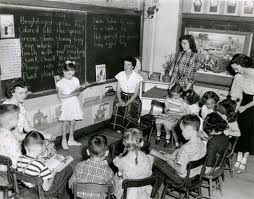The Opinion Research Corporation (ORC) claimed:
A significant result of the program has been to check the school use of many materials that are anti-business in nature. Another result has been an increased willingness on the part of teachers to use materials furnished by business... Never before had teaching officialdom told teachers it was alright to use commercial materials provided they measure up to these criteria [educational and free of direct sales promotions]...
The Bureau believes an important public relations job for business is being done, and that teachers, consequently, are developing a much friendlier attitude toward American business.
 A 1951 study found that 89% of teachers surveyed used industry-sponsored materials in their classes. Another, a few years later, found that 77% of all films shown in schools surveyed were donated sponsored films.
A 1951 study found that 89% of teachers surveyed used industry-sponsored materials in their classes. Another, a few years later, found that 77% of all films shown in schools surveyed were donated sponsored films.
The ORC found that same year that three quarter of social studies teachers reported receiving teaching aids from private corporations on the way business systems operate. Some described the material as ‘one-sided, biased, smacks of propaganda, never admits any faults in the system.’ However, most teachers tended to have high regard for the capitalist, free enterprise system and social studies teachers were particularly open to receiving and using the corporate material.
Some companies used consultants or teachers to design the materials so as to ensure their acceptability in the schools and give the impression that the materials, although sponsored, were neutral and independent. The National Education Association was not so particular, endorsing the use of all sponsored materials saying that ‘No material is necessarily good or bad in itself. Probably nearly all free materials could serve a useful and constructive outlet in the classroom’ provided it was used with care. The National Science Teachers Association admitted that by the late 1950s ‘teachers and administrators have greater confidence in industry and in the motives behind industry’s offerings to schools.’ This was a major change from the immediate post war years.
The unions, however, did object to much of this material. In Ohio they unsuccessfully tried to stop a history text prepared by the Chamber of Commerce from being introduced. The text omitted reference to unions but devoted large sections to the rubber companies and to the Quaker Oats Company. Some unions tried to get their own materials into schools but without much success, since they ‘had neither the resources nor the commitment to match business in the schools’. They were too busy fighting more immediate battles in the workplace.
By the end of the 1950s the business point of view had become the accepted truth in many schools and students were, in the words of economics professor Daniel Fusfeld, ‘captives of the ideology of the right, ... indoctrinated’ with the idea that an economy which was ‘free, competitive and individualistic’ had to be maintained.
 Despite this triumph, the need for economic ‘education’ continued to be promoted by business people in the 1960s. The President of the New York Stock Exchange told the National Association of Secondary School Principals in 1960 that the economic literacy of the American people was ‘shockingly inadequate’ and that it was up to the educational system to correct the situation. Economics professors at the college level complained that they had to ‘unlearn’ the students: ‘We have a big job to do in just what you might call ‘unlearning’ the students who have all kinds of notions — they can’t understand, for instance, how banks can create money.’
Despite this triumph, the need for economic ‘education’ continued to be promoted by business people in the 1960s. The President of the New York Stock Exchange told the National Association of Secondary School Principals in 1960 that the economic literacy of the American people was ‘shockingly inadequate’ and that it was up to the educational system to correct the situation. Economics professors at the college level complained that they had to ‘unlearn’ the students: ‘We have a big job to do in just what you might call ‘unlearning’ the students who have all kinds of notions — they can’t understand, for instance, how banks can create money.’
Lucille Ford, in her 1967 PhD thesis, surveyed 90 organizations that were active in economic education and/or economic persuasion. Nearly all of these made their materials available to schools and about a third especially designed materials for schools from elementary level through to college level. She identified five types of organizations providing this material:
These organizations produced teaching aids and also teaching units consisting of printed materials, films, record sets, text books, activity books, teachers guides, wall charts, and tests. They also provided speakers, tours, awards programs, and career conferences and programs for secondary school students and symposia, seminars, workshops and panel discussions for college students.
Some of these organizations were explicit in their ideology such as the National Economic Council which stated its commitment to ‘prevent increases in government spending’ and to ‘unbuild the Federal bureaucracy’ amongst other things. Others maintained a veneer of objectivity.